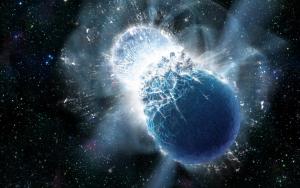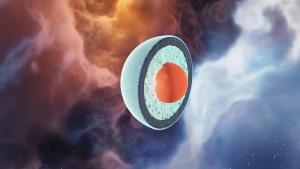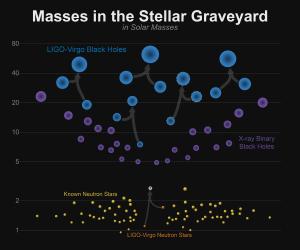Blog
To Be or Not to Be
13 November 2020
 Dana Berry, SkyWorks Digital, Inc.
Dana Berry, SkyWorks Digital, Inc.In principle, creating a stellar-mass black hole is easy. Simply wait for a large star to reach the end of its life, and watch its core collapse under its own weight. If the core has more mass than 2 - 3 Suns, then it will become a black hole. Smaller than about 2.2 solar masses and it will become a neutron star. Smaller than 1.4 solar masses and it becomes a white dwarf.
Black holes could also form through the collision of two neutron stars. If they merge into an object with more than the critical limit, then they should create a black hole. But what exactly is that limit? A new study in Physical Review Letters looks to answer that question.1 The team ran several computer simulations of neutron star mergers and found that the critical limit isn’t just a matter of the total mass of the two stars. Instead, the result depends upon the interior structure of the neutron stars, which is something we still don’t fully understand.
 Jyrki Hokkanen, CSC - IT Center for Science
Jyrki Hokkanen, CSC - IT Center for ScienceThe interior of a neutron star depends upon the equation of state of nuclear matter, which describes things such as how stiff the material is and how well it conducts heat. There are several proposed equations of state, each with slightly different properties, so the team simulated mergers with a range of equations of state.
They found that if the interior of a neutron star is relatively elastic or “soft” then even a merger of small neutron stars will create a black hole. But if the interior is stiffer, then they won’t collapse into a black hole. Instead, they will create a large, rapidly rotating neutron star that can resist gravitational collapse. One critical factor determining the result is whether the nucleons break apart into quarks during the collision.
 LIGO-Virgo/Frank Elavsky/Northwestern University
LIGO-Virgo/Frank Elavsky/Northwestern UniversityThis research could prove crucial to our understanding of neutron stars and black holes. In 2017, the gravitational wave observatories LIGO and Virgo detected the merger of two neutron stars, though they couldn’t tell whether the result was a black hole or a large neutron star. Over time, more of these mergers should be seen, and we should be able to determine the critical limit for creating a black hole. Combined with this new work, we should be able to pin down which equation of state provides the best description of neutron star interiors.
Andreas Bauswein, et al. “Equation of State Constraints from the Threshold Binary Mass for Prompt Collapse of Neutron Star Mergers.” Physical Review Letters 125.14 (2020): 141103. ↩︎